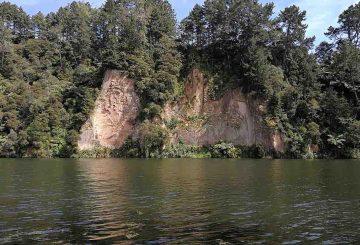Bus travel and coach transport is ideal if you prefer to make your way around New Zealand without the hassle of self-driving.
This is a cost-effective alternative to air travel with daily scheduled passenger services available throughout the country. There’s also a multitude of coach companies serving the main towns and cities with Local services.
There are four different ways to travel across New Zealand by bus:
National Coach Services:
The most extensive public transport network in New Zealand is the national coach buses. This is the mode of public transport which will get you to most places.
The main national coach bus company in New Zealand is InterCity , however there are a number of small companies as well.
With national coach buses, single trip tickets can be purchased taking you from A to B. Bus passes can also be purchased, which is a great option if you plan to use InterCity on a regular basis.
For example, InterCity do a FlexiPass bus pass which runs on a “travel hours” basis, and they do a TravelPass bus pass which is a bus pass for a set route around the country including a few activities.
Using the national coach buses are easy. You can book your trip online or with most travel agents and accommodations in New Zealand. The bus show up at the required bus stop 15 minutes before the departure time. The bus driver usually asks for a name and booking number (or bus pass details) then you hop on the bus.
Bus trips usually involve a couple of 10-minute toilet/coffee breaks, as well as a 30-minute lunch break. Bus drivers give commentary on the speakers along the way and announce when approaching stops (so you’ll know when you reach your stop).
Backpacker Tour Buses
Another way to see New Zealand is on a bus tour. This is a guided route around the country with a group, a bus and a couple of tour guides or driver guides. Bus tours come with a lot of inclusions, such as accommodation, meals and some activities.
The bus companies that run tours in New Zealand include Contiki, G Adventures, Sweet As Travel, Haka Tours, Wild Kiwi, Topdeck and Flying Kiwi. What makes them “backpacker” tours is that they mostly attract young travellers, aged 18 – 30 years old, that are looking for an action-packed trip in New Zealand.
With bus tours, you have a huge variety of tours to choose from ranging 3 to 24 days. You pay for the whole trip before your chosen departure date, which often includes accommodation in a hostel dorm/tent in a camp site, at least one meal a day and some activities. You also have the option to choose some activity add-ons, upgrade to a private room or cabins, and provide information on any dietary requirements.
From there, you travel to New Zealand and usually, tour groups will have an “introduction” evening giving you a chance to meet everyone the day before the tour. Otherwise, turn up at the designated bus stop of meeting place on the trip departure date and away you go!
You will have a tour guide who will look after you for the whole trip. They will help organise booking for any additional activities you might want to do. Plus, make you aware of each days’ itinerary. They usually prepare meals or organise to make meals together as a group. As all tour guides do, they also give commentary as you are travelling through the country.
Hop-on Hop-off Buses
Like bus tours, hop-on hop-off buses follow set routes across the country with the option to “hop-off” just about anywhere along the route. Unlike bus tours, accommodation, meals and activities are not included in the price but are run on a more “pay-as-you-go” basis.
Bus passes for a chosen route are booked and paid for before departure. You can even buy a pass and decide your departure date later (as long as it’s within 12 months of purchasing the pass).
When you’re ready, book your departure date and meet your bus at the given location and time. From your departure date, bus passes are valid for one year.
For national routes, you are able to complete a route multiple times with a few conditions. You will meet your driver-guide who is your driver, tour guide and travel agent, where you will give your name and/or passenger number to get on the bus. Throughout each day that you travel on the bus (as opposed to the days that you hop off and do your own thing), there will be plenty of toilet/refreshment stops, short walks, photo stops, supermarkets and more.
Clipboards will go around the bus to sign up to accommodation choices and activity choices (if any) that you want the driver to book and organise for you. Accommodation is usually hostels with communal kitchen and lounge facilities. You pay for your accommodation and activities on arrival to said accommodation or activity.
Because meals are not included, you have the choice to eat out (if available) or cook in the hostel kitchen with food you would have bought at the supermarket stops.

















































